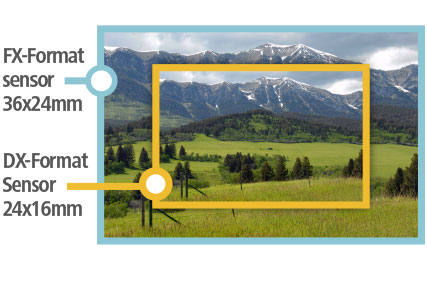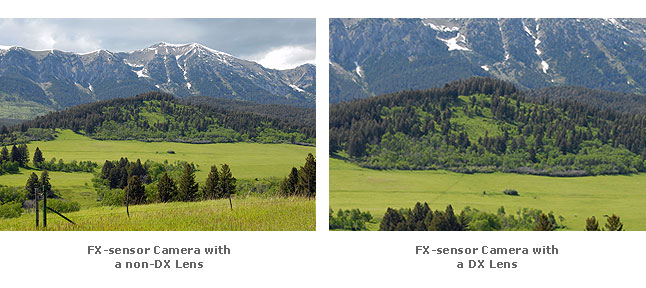The DX and FX Formats
What is camera format? What does camera format mean?
In digital SLR cameras, the camera's format refers to the size of its image sensor. Nikon makes a DX-format sensor and an FX-format sensor. The DX-format is the smaller sensor at 24x16mm; the larger full frame FX-format sensor measures 36x24mm which is approximately the same size as 35mm film.
Different NIKKOR lenses are designed to accommodate the different camera sensor sizes. DX cameras with smaller sensors are optimized for corresponding DX lenses. The DX designation can be found in the lens name, i.e. AF-S DX Zoom-NIKKOR 12-24mm f/4G IF-ED. These lenses are smaller and lighter in weight and address the market's need for affordable, high-performance lenses with a variety of focal lengths and zoom options.
Can you use an FX lens on a DX camera body?
Yes. DX lenses and FX lenses can be used interchangeably. So if you went from an FX camera to a DX format DSLR, your full frame FX lenses will still work. The DX sensor makes the production of lighter, smaller cameras possible, but because it covers a smaller portion of the image projected by the lens, a 1.5x crop factor is introduced—so called because the smaller sensor crops the image compared to an image from a 35mm film frame. This means, for example, a 24mm lens on a DX sensor camera provides an approximate 36mm view.
Can you use a DX lens on an FX camera body?
If you are upgrading from a DX to a full frame FX format camera you can still use DX lenses since the camera will automatically compensate. However, to avoid vignetting, the DX crop mode is automatically selected by the camera when a DX lens is attached.
On a full frame FX-format camera with a DX lens mounted, the camera will automatically engage its built-in DX crop mode, thus recording an image only from the center section of the sensor.
Is FX full frame?
Yes, FX camera bodies and lenses are full frame! The FX sensor, with more "light gathering" area, offers higher sensitivity and, generally, lower noise. There is, of course, no crop factor present with the FX sensor with an FX or full frame lens.
DX cameras have the added benefit of being able to use both DX and non-DX NIKKOR lenses—those lenses without the DX designation in their names, i.e. AF-S NIKKOR 14-24mm f/2.8G ED. And here's why.
Each lens is designed to cast an image circle on the camera's sensor. The circle cast by a DX lens is smaller and corresponds to the size of a DX sensor. Non-DX lenses cast a larger image circle corresponding to an FX-format sensor. The DX-format camera can use both types of lenses (DX and FX) since the non-DX lens image circle is larger than needed on a DX-format camera.
On an FX-format camera with a DX lens mounted, the camera will automatically engage its built-in DX crop mode, thus recording an image only from the center section of the sensor.
Crop modes - Understanding the DX and FX Crop Modes in Nikon DSLR cameras







